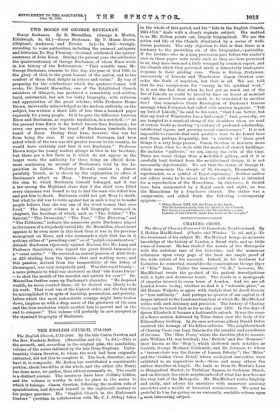CHARING CROSS.
The Story of Charing Cross and its Immediate Neighbourhood. By J. Holden MacMichael. (Chatto and Windus. 7s. 6d. net.)—To the treatment of his subject Mr. MacMichael brings an accurate knowledge of the history of London, a fluent style, and no little sense of humour. He has studied the annals of the Metropolis with the sedulous care of the historian ; and the numerous references upon every page of the book are ample proof of the wide extent of his research. Indeed, in his weakness for footnotes he somewhat resembles the conscientious George Dyer of "Elia" fame. Unlike the immortal "G. D.," however, Mr. MacMichael treats the product of his patient investigations with a light and dexterous touch. The result is a monograph of singular interest to every lover of London. And we are all London lovers to-day, whether we find it a " tolerable place," as did Horace Walpole, or agree with Carlyle that to dwell therein is "true sublimity." And perhaps no quarter of our capital is of deeper interest to the Londoner than that of which Mr. MacMichael writes with such intimacy and precision. Tho history of Charing Cross can be traced back as far as the year 1292. In the days of Queen Elizabeth it became a fashionable suburb. It was the scene of a fierce oration delivered by Titus Oates over the body of Sir Edmondbury Godfrey. In its once notorious pillory Daniel Defoe received the homage of his fellow-citizens. The neighbourhood of Charing Cross was long famous for the number and excellence of its inns. The Blue Posts,' where the Jacobite plot to assassi- nate William III. was hatched ; the ' British' and the Rummer' (now known as the ` Ship '), which sheltered such notables as Garrick, George Morland, Goldsmith, and Dr. Johnson, to whom a "tavern chair was the throne of human felicity "; the `Mitre' and the ' Golden Cross Hotel,' where zoological curiosities were exhibited to an inquisitive mob,—these and many others the author describes at length. He leads us from St. Martin's Lane to Hungerford Market, to Trafalgar Square, to Cockspur Street, and on through the whole neighbourhood of what has now become the very hub of the Metropolis. Mr. MacMichael writes brightly and easily, and adorns his narrative with numerous amusing anecdotes and a wealth of historical reminiscence. We must be grateful to him for giving us an eminently readable volume upon a most interesting subject.


























































 Previous page
Previous page